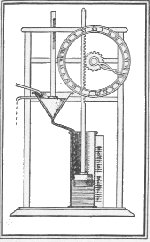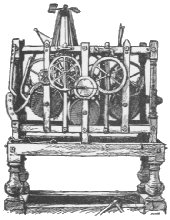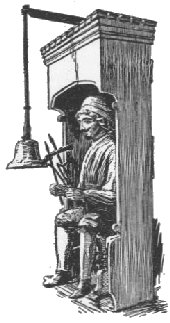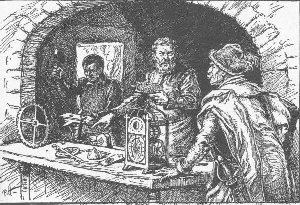THE BEGINNING OF CLOCKS AND WATCHES
The Sundial—The Clepsydra—The Sandglass—The Wholly Mechanical Clock—The First Watch—John Harrison and his Marine Chronometer__Arnold’s Tiny Repeating Watch.
VERY early in the history of civilization man must have felt the need of a means of measuring time. In the far-distant Stone Age he must have soon noted that the shadows cast by familiar objects moved in a regular manner, according to the hour, and no doubt made use of this knowledge to arrange meeting places near to such objects when the shadows should have reached a given mark.
In the heavens above he observed the godlike progress of the sun, so regular in its movements, and his own habits of waking and working and sleeping must, willy-nilly, depend upon it. Later on, as he learned to know and recognize the ordered procession of the stars, he had a clock by night as well as by day, and as the ages moved on and existence became more complicated he divided periods of time into "moons" and then into years, all by means of the heavenly bodies.
But this came slowly, and much more slowly came a measuring instrument. We do not hear of the sundial until some twenty-seven centuries ago, which is quite a brief span in the many millions of years that have passed since man first realized that "time flies." The sundial however, was invented long before these known records and, after all, was only a step onward from the cave man’s habit of using fixed objects and their shadows to mark the flight of time.
But as the sundial depended upon the beams of a sun which did not always shine
 |
From "Time telling through the Ages" by permission of the Ingersoll Watch Co., Ltd. |
The first water clock was, however, but a rough-and-ready machine, and the next onward step was the addition of a smaller jar above, from which the water dripped into the larger one. As the level rose in the latter it carried up with it a float which marked the hours against an indicator upon the side of the jar.
This arrangement of twin jars gave more accurate timekeeping, but a more definite stage was reached when, about 140 B.C., a Greek of Alexandria applied a cogwheel and a toothed rod. The latter was fixed on the float and moved the wheel as the water rose in the jar.
We have come now, as our illustration shows, to the clock face and the moving hand indicating the hours, and the rest of the mechanism of the wholly mechanical clock was only a question of time, although more than a thousand years
 |
How deeply interesting are the origins of the common everyday things of our complicated life of to-day is seen in the beautifully illustrated book, "Time Telling through the Ages",1 which the Ingersoll Watch Company have provided as an expression of their own deep interest in their business of making watches and clocks. This liberal contribution to the literature of the subject bears the impress of the true craftsman.
Nothing is known with certainty as to the origin of clocks such as have been generally used during modern times. Probably they date back to the twelfth century, although the first known description refers to one which was sent by the Sultan of Egypt to the Emperor Frederick II
 |
We know that watches made their appearance very
 |
early in the sixteenth century, for an old writer of 1511 wrote of one Peter Henlein, who "creates works that are the admiration of leading mathematicians, for out of a little iron he constructs clocks with numerous wheels which, without any impulse and in any position, indicate time for forty hours and strike, and which can be carried in the purse as well as in the pocket."
We can understand and sympathize with the enthusiasm of old Johannes Coeuleus, although we know that the cumbersome originals of the dainty creations manufactured to-day were for a long period little more than toys. By Queen Elizabeth’s time all wealthy people had watches, but the world had to wait until the eighteenth century for the chronometer, in its essence a large watch, the movement of which is made from metals which heat and cold affect differently, so that in combination they provide a balance, or "compensation", as it is termed, which prevents the variation of temperature affecting its power of accurate timekeeping.
When Columbus discovered America, in the fifteenth century, the age of long voyages began, and at once seamen were in great need of some instrument by means of which they might work out longitude.
There was none except the log, that rough marine speedometer which, after all, gave very little help. Philip II of Spain offered the huge reward of one hundred thousand crowns, and a little later the Dutch were in the field with a promise of thirty thousand florins for such an instrument. When Charles II established Greenwich Observatory he urged upon his Astronomer Royal the desirability of satisfying this bitter need of navigators, but even with the help of the great Sir Isaac Newton nothing could be done.
Having given this explanation, I will tell you something of John Harrison, the man who made the first chronometer and so conferred a boon beyond words upon all those whose business is upon the great waters. Harrison was born at Foulby in Yorkshire in the year 1693, and began life as a carpenter. He was still a very young man when, in the year 1714, a petition was presented to Parliament by several captains in the Navy and a number of London merchants, setting forth the importance of some means by which navigators out of sight of land could find out the exact longitude.
The petition was referred to a committee, and Sir Isaac Newton giving evidence before this committee hit the nail on the head. "One [method]," he said, "is by a watch to keep time exactly; but by reason of the motion of the ship and the variation of heat and cold, wet and dry, and the difference of gravity in different latitudes, such a watch hath not yet been made." The British Government then passed an Act offering £10,000 to any one who should discover a method of determining the longitude within one degree or sixty miles; £15,000 if the method proved accurate within forty miles; and £20,000 if determined within thirty miles.
It was a splendid reward, for in those days £20,000 was a great fortune. It tempted even so great a man as Sir Christopher Wren, the architect of St. Paul’s, to make a vain effort to solve the problem. Yet where all the greatest men of science tried and failed it was the son of a poor carpenter, a boy who had barely learned to read and write, who in the end succeeded.
A real inventor is born, not made, and young Harrison from a baby not only loved to see wheels go round, but longed to know how and why they went. When only a tiny lad of six he fell ill with smallpox, the worst scourge of the country at that period, and while he lay hot and parched with the terrible fever, a going watch placed in his small hands quieted him and filled him with delight.
When he grew older he became a carpenter, like his father, but still he loved wheels, and began experiments in clockmaking. A large clock made almost entirely of wood by Harrison when only twenty-two years old is still preserved in the South Kensington Museum. Later Harrison turned entirely to clockmaking, and worked desperately hard. A kind clergyman lent him books, and soon he was not only equal to the clockmakers of his time, but had gone beyond them.
Presently, in 1726, came his great invention, the compensation pendulum. Since all metals contract with cold and expand with heat the ordinary pendulum grows longer in hot weather and shorter in cold, so that the clock of which it forms a part is not dependable. But all metals do not alter equally, and Harrison noticed this and made a pendulum like a gridiron of alternate bars of steel and brass, so arranged that the bars which expanded most were countered by those which had least expansion. One of these clocks which he kept by him did not vary so much as one minute in ten years.
Harrison began to think much of the great prize, which, although it had been on offer for fourteen years, had never yet been claimed, and in 1728 went up to London to show his drawings to Dr. Halley, the Astronomer Royal. The astronomer sent him to George Graham, the greatest of London’s clockmakers, who generously praised his work, but said that he had better go home and make his machine before applying to the Board of Longitude.
Now began a time of terrible trial for the plucky clockmaker. He had to make a living while he worked; he had to make his own tools and to teach himself to work in brass and other metals in which he had had little experience. No one backed him with money, and he was obliged to earn all that he needed for the purchase of tools and materials. All sorts of difficulties arose. For instance, in an ordinary watch as then made, time was lost during the process of winding. Harrison inserted a secondary spring which kept the works going while the winding was being done. It took him seven years to make his first chronometer, and this, set in a special frame, was tried on a sea-going barge and found to work well.
In 1735 Harrison went to London again and submitted his chronometer to the Royal Society, who examined it with great interest and gave him a certificate stating that the principles of his invention promised a great degree of exactness. The chronometer was then shown to the Admiralty and given a trial on the Centurion, a man-of-war. Harrison went with it and came back in another warship, the Orford. On the way back, when the ship first sighted land, the captain and officers thought that this land was Start Point, but Harrison, working by his chronometer, declared that it was the Lizard. Harrison was right; the navigators were no less than ninety miles out of their reckoning. The captain gave Harrison a letter describing the amazing success of his chronometer, and Harrison at once went before the Board of Longitude, no doubt fully expecting that he would receive the £20,000. They voted him £500 for expenses toward making a new and less cumbersome instrument, of which money only half was paid down.
This new timekeeper Harrison completed in 1739, yet not satisfied with it made a third and still smaller machine. But various difficulties arose, especially in the tempering of springs, and it was not until 1749 that Harrison completed a chronometer which fully satisfied him. During all these years he had lived and worked on two grants of £500 each.
The Royal Society, who, as on the previous occasion, fourteen years earlier, were the first to see the new chronometer, were delighted with it and awarded Harrison the highest prize in their power, the Gold Medal. In his speech, when making the presentation, the president spoke of Harrison as the "most modest person he had ever known", and of his chronometer as working with "a degree of exactness that is astonishing, even stupendous, considering the immense number of difficulties which the author of this invention must have had to encounter."
Now you might surely suppose that the Board of Longitude would have paid over the well-earned £20,000. But not a bit of it! It was not until the year 1761 that the third timekeeper was given a trial aboard the Dorsetshire bound for Jamaica. Harrison’s son William went with it, and came back in the Deptford. The chronometer worked to perfection and corrected the log of the Deptford to the extent of no less than three degrees of longitude. After all this voyaging the chronometer, when tested on return, was found to be correct within five seconds.
Still poor Harrison could not get his money. For thirty-five years he had worked as few men have worked, and had conferred on his nation one of the greatest benefits that any one man has conferred on his country, yet the Board would not certify that he had won the prize. Harrison petitioned Parliament, and an Act was passed giving the inventor £5000. Still the wretched Board haggled disgracefully. They paid him a small sum on account, and two more years dragged by. In September 1764 Harrison managed to get another thousand pounds, and in the following year the Board passed a resolution that the inventor was entitled to the whole reward as offered in the Act of 1714. Yet still it was not paid over.
Other countries were not so stingy. The King of Sardinia ordered four of Harrison’s chronometers, paying him a thousand pounds apiece. Harrison was now seventy-three, his eyesight was failing, yet still he struggled for his just dues. He wrote the Board the stiffest letter those gentlemen had ever received, and there followed a stormy interview. But at last half the money was forthcoming, with a promise of the other half as soon as his other chronometers had been tested.
The test was made by no less a person than the great Captain Cook in his memorable voyage round the world,2 and in 1773, forty-five years after his first experiments, John Harrison received the remainder of his hard-earned money. He died three years later, at the age of eighty-three; his tombstone may still be seen in Hampstead Parish Churchyard.
Harrison’s great successor in the art of making clocks and watches was John Arnold. Harrison’s chronometer was so complex that its price was £400. Arnold decided that something smaller could be made, and set himself to work. In 1776 he invented the cylindrical spring and the compensation balance, and applied these to a new chronometer. Arnold was much better treated than Harrison, for the Government awarded him a sum of £3000 down.
Arnold was also the inventor of the method of "jewelling" watches and clocks; that is, he used precious stones for those parts which have to withstand most wear. Jewels, such as rubies, are far harder than even the best steel, and so will last longer than metal bearings and give better results. In 1771 Arnold applied ruby "pallets" to the great astronomical clock which had been made by Graham for Greenwich Observatory.
Arnold was a wonderful workman, and made the smallest repeating watch ever known. It was made for King George III, and presented to him on his birthday, June 4, 1764.
It was only six tenths of an inch in diameter and the weight of a sixpence, yet it kept perfect time and repeated the hours, half-hours, and quarters with a tiny tinkling chime. The king was delighted with it, and made Arnold a present of five hundred guineas. The Czar of Russia saw the watch and offered Arnold a thousand guineas to make another like it, but Arnold reluctantly refused, saying that his eyes would not stand the strain.
Chronometers continued to be improved, and in 1830 two were made for Greenwich Observatory by Charles Frodsham. They were observed daily for twelve months, and in a certificate granted to their maker it was stated that one made an extreme daily variation of the eighty-six-hundredth of a second, the other of fifty-seven-hundredths only. An amazing record and one extremely creditable to British watchmakers.
1By Harry C. Brearley (Doubleday, Page & Company).
Return to text.
2See "The Book of Discovery", chaps. xxiv—xxvi.
Return to text.
Chapter 6
Chapter 4
Table of Contents
Return to Main Page
© 2000, 2001, 2002 by Lynn Waterman